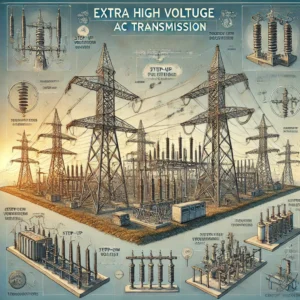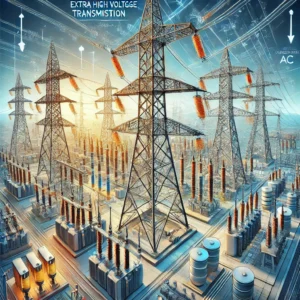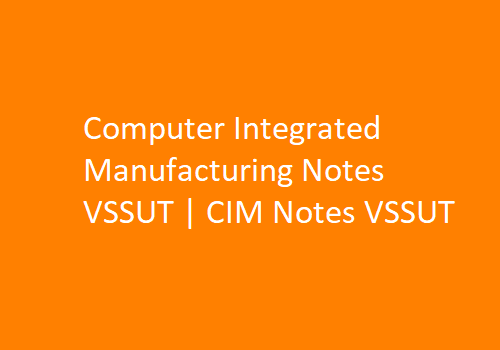Here you can download the Free lecture Notes of Extra High Voltage AC Transmission Notes Pdf- EHV AC Transmission Notes Pdf materials with multiple file links to download. The Extra High Voltage AC Transmission Notes Pdf – EHV AC Transmission Notes Pdf book starts with the topics covering Preliminaries: Necessity of EHV AC transmission, Line inductance and capacitances, Voltage gradients of conductors: Electrostatics, Power loss and audible noise (AN), Radio interference (RI), Electrostatic field: calculation of electrostatic field of EHV/AC lines, Traveling wave expression and solution, Power circle diagram and its use, Etc.

Extra High Voltage AC Transmission Notes Pdf- EHV AC Transmission Notes Pdf
Complete Notes
Link: Complete Notes
Note :- These notes are according to the R09 Syllabus book of JNTU. In R13 and R15,8-units of R09 syllabus are combined into 5-units in R13 and R15 syllabus. If you have any doubts please refer to the JNTU Syllabus Book.
Extra High Voltage (EHV) AC Transmission plays a vital role in modern power systems, enabling the efficient and reliable transmission of electrical power over long distances. It utilizes very high voltage levels, typically above 230 kV, to minimize power losses and enhance transmission capacity. The EHV AC Transmission Notes PDF offers a detailed exploration of the principles, challenges, and technological advancements in EHV AC transmission, making it an essential resource for B. Tech students specializing in electrical engineering.
These notes are meticulously designed to align with the JNTU syllabus, providing a comprehensive understanding of various aspects of EHV AC transmission Notes. The content covers a wide range of topics, including the necessity of EHV AC transmission, line inductance and capacitance, voltage gradients, corona effects, electrostatic fields, traveling wave theory, and voltage control mechanisms. With clear explanations, illustrative examples, and practical insights, the notes serve as a valuable tool for both theoretical learning and practical applications in the field.
Topics Covered in Extra High Voltage AC Transmission Notes


The EHV AC Transmission Notes PDF covers a comprehensive range of topics that are fundamental to understanding the complexities and applications of EHV AC transmission. Below is an in-depth outline of the key topics included in the notes:
UNIT I: Introduction to EHV AC Transmission
- Necessity of EHV AC Transmission: Discusses the increasing demand for EHV AC transmission in modern power systems. Highlights the advantages of using extra high voltage levels, such as reduced power losses, improved power handling capacity, and enhanced system stability. It also addresses the challenges and problems associated with EHV AC transmission, including economic considerations and environmental impacts.
- Power Handling Capacity and Line Losses: Examines the power handling capabilities of EHV AC lines and the factors affecting them. Discusses how power losses occur in transmission lines and presents methods to calculate and minimize these losses, such as using bundled conductors and optimizing conductor spacing.
- Mechanical Considerations: Focuses on the mechanical properties of transmission line conductors, including resistance, tensile strength, and thermal expansion. Explores the design considerations for bundled conductors, including bundle spacing, bundle radius, and their impact on electrical and mechanical performance.
- Examples and Case Studies: Provides practical examples and case studies illustrating the application of EHV AC transmission concepts in real-world scenarios. These examples help students understand the practical challenges and solutions in designing and operating EHV AC transmission lines.
UNIT II: Line and Ground Reactive Parameters
- Line Inductance and Capacitance: Provides a detailed study of the inductive and capacitive properties of transmission lines. Discusses the calculation of line inductance and capacitance, including self and mutual inductance, and the impact of these parameters on power transmission efficiency and stability.
- Sequence Inductances and Capacitances: Explores the concept of sequence inductances and capacitances in three-phase transmission systems. Discusses how these parameters affect the propagation of electrical signals and the stability of the transmission system.
- Modes of Propagation and Ground Return: Analyzes different modes of wave propagation in transmission lines, including direct, ground, and space wave modes. Discusses the impact of ground return on line parameters and the techniques used to mitigate its effects.
- Examples and Problem Solving: Includes examples and problem-solving exercises to reinforce the understanding of line inductance, capacitance, and propagation modes. These exercises help students apply theoretical knowledge to practical scenarios, enhancing their problem-solving skills.
UNIT III: Voltage Gradients of Conductors
- Electrostatics in Transmission Lines: Introduces the principles of electrostatics and their application in EHV AC transmission. Discusses the electric field generated by line charges and the methods used to calculate the field strength and distribution.
- Field of Sphere Gap and Line Charges: Explores the electric field distribution around spherical conductors and line charges. Discusses the significance of the sphere gap in measuring high voltages and its application in EHV AC systems.
- Charge and Potential Relations for Multi-Conductors: Examines the relationship between charge and potential in multi-conductor systems. Provides mathematical models and formulas for calculating the surface voltage gradient on conductors and the distribution of voltage gradients on sub-conductors of bundled conductors.
- Practical Applications and Examples: Provides practical examples and applications of voltage gradient calculations in EHV AC transmission systems. Discusses how to mitigate the effects of high voltage gradients on conductor surfaces to prevent insulation breakdown and corona discharge.
UNIT IV: Corona Effects – Part I
- Corona Loss and Audible Noise (AN): Discusses the phenomenon of corona discharge in EHV AC transmission lines and its effects on power transmission. Explores the mechanisms of corona loss, including ionization of air, charge-voltage relationships, and the generation of audible noise (AN).
- Corona Loss Formulae and Charge-Voltage Diagram: Provides detailed corona loss formulae for calculating power loss due to corona discharge. Discusses the charge-voltage diagram and its significance in understanding corona characteristics and predicting corona inception voltage.
- Generation, Characteristics, and Limits of Audible Noise: Discusses the generation and characteristics of audible noise produced by corona discharge. Provides guidelines and limits for acceptable AN levels in EHV AC systems and methods for measuring and mitigating AN.
- Examples and Case Studies: Includes examples and case studies on corona loss and audible noise in EHV AC transmission systems. Discusses practical techniques for minimizing corona loss and controlling audible noise in high-voltage environments.
UNIT V: Corona Effects – Part II
- Radio Interference (RI): Examines the impact of corona discharge on radio interference (RI) in EHV AC transmission systems. Discusses the generation of corona pulses, their properties, and the limits associated with RI in power transmission.
- Frequency Spectrum and Modes of Propagation: Provides an analysis of the frequency spectrum of RI generated by corona discharge. Discusses different modes of propagation and their impact on radio communication and signal integrity in power systems.
- Measurement of RI, RIV, and Excitation Functions: Discusses the methods used to measure radio interference voltage (RIV) and excitation functions in EHV AC systems. Provides guidelines for mitigating RI and enhancing signal integrity in high-voltage environments.
- Practical Applications and Examples: Includes practical applications and examples related to RI measurement and mitigation in EHV AC transmission systems. Discusses how to design transmission lines and insulators to minimize RI and ensure compliance with regulatory standards.
UNIT VI: Electrostatic Field Analysis
- Calculation of Electrostatic Fields in EHV AC Lines: Provides methods for calculating the electrostatic field generated by EHV AC lines. Discusses the impact of these fields on the surrounding environment, including the effects on humans, animals, and plants.
- Effects of Electrostatic Fields on Humans, Animals, and Plants: Explores the biological and environmental effects of electrostatic fields generated by EHV AC lines. Discusses safety guidelines and standards for protecting living organisms from harmful exposure to high electrostatic fields.
- Electrostatic Induction and Electromagnetic Interference: Discusses electrostatic induction in unenergized circuits and the electromagnetic interference (EMI) caused by EHV AC lines. Provides techniques for mitigating EMI and enhancing the compatibility of power systems with electronic devices.
- Examples and Problem Solving: Includes examples and problem-solving exercises on electrostatic field calculations and EMI mitigation. These exercises help students apply theoretical knowledge to real-world scenarios, enhancing their analytical skills.
UNIT VII: Traveling Wave Theory
- Traveling Wave Expression and Solution: Introduces the theory of traveling waves in transmission lines and their significance in EHV AC systems. Provides mathematical expressions and solutions for traveling waves, including wave propagation speed, attenuation, and reflection.
- Source of Excitation and Terminal Conditions: Discusses the sources of excitation for traveling waves, such as lightning strikes and switching operations. Explores terminal conditions in transmission lines, including open-circuited and short-circuited ends, and their impact on wave behavior.
- Reflection and Refraction Coefficients: Provides formulas and methods for calculating reflection and refraction coefficients in transmission lines. Discusses the impact of these coefficients on wave propagation and voltage stability in EHV AC systems.
- Lumped Parameters and Generalized Constants: Examines the concept of lumped parameters in distributed lines and the use of generalized constants for modeling transmission line behavior. Discusses no-load voltage conditions and charging current in EHV AC systems.
- Practical Applications and Examples: Includes practical applications and examples related to traveling wave theory in EHV AC transmission systems. Discusses techniques for designing transmission lines to minimize wave reflection and ensure voltage stability.
UNIT VIII: Voltage Control and Compensation
- Power Circle Diagram and Voltage Control: Discusses the use of power circle diagrams for voltage control in EHV AC transmission systems. Provides guidelines for interpreting power circle diagrams and using them to optimize voltage regulation and reactive power management.
- Voltage Control Using Synchronous Condensers: Explores the use of synchronous condensers for dynamic voltage regulation in EHV AC systems. Discusses the principles of operation, design considerations, and advantages of using synchronous condensers for voltage control.
- Cascade Connection of Shunt and Series Compensation: Discusses the concept of cascade connection of shunt and series compensation for enhancing voltage stability and power transfer capability in EHV AC systems. Provides guidelines for designing and implementing compensation schemes in high-voltage transmission lines.
- Sub-Synchronous Resonance in Series Capacitor-Compensated Lines: Examines the phenomenon of sub-synchronous resonance (SSR) in series capacitor-compensated lines. Discusses the causes, effects, and mitigation techniques for SSR in EHV AC transmission systems.
- Static VAR Compensating System: Provides an overview of Static VAR Compensators (SVCs) and their role in dynamic voltage regulation and reactive power management. Discusses the principles of operation, design considerations, and benefits of using SVCs in EHV AC systems.
- Examples and Case Studies: Includes examples and case studies on voltage control and compensation techniques in EHV AC transmission systems. Discusses practical approaches for optimizing voltage stability and enhancing power system performance.
Download Links for Extra High Voltage AC Transmission Notes PDF
To facilitate easy access to study materials, the EHV AC Transmission Notes PDF is available for free download. The notes are organized by unit, allowing students to download specific content as needed for targeted study and revision.
- Complete Notes
Link: Complete Notes - Unit 1 Notes
Link: Material 1 Notes - Unit 2 Notes
Link: Material 2 Notes - Unit 3 Notes
Link: Material 3Notes - Unit 4 Notes
Link: Material 4 Notes
Benefits of FREE Extra High Voltage AC Transmission Handwritten Notes PDF
Comprehensive Coverage: The notes provide thorough coverage of all critical topics required for a deep understanding of EHV AC transmission systems. They are ideal for students preparing for exams and practical applications in electrical engineering.
Easy to Understand: Handwritten notes that break down complex concepts into simple, easy-to-understand explanations, enhancing student comprehension and retention.
Aligned with JNTU Syllabus: The content is meticulously tailored to align with the JNTU syllabus, ensuring relevance and accuracy in study materials.
Free and Accessible: These notes are available for free download, providing a cost-effective solution for students needing quality study materials without incurring additional costs.
High-Quality Study Material: Curated by experienced faculty, these notes offer high-quality content and are a reliable resource for exam preparation, making them a trusted tool for academic success.
DOWNLOAD NOW
Frequently Asked Questions (FAQs)
Q1. Where can I download the Extra High Voltage AC Transmission Notes PDF?
You can download the notes from the provided links for each unit or the complete set from Smartzworld.
Q2. How to download the EHV AC Transmission Notes PDF?
Click on the respective links for each unit or the complete notes to start downloading. The download process is straightforward and user-friendly.
Q3. How many modules are covered in the EHV AC Transmission Notes PDF?
The notes cover a total of eight modules, each focusing on a specific aspect of EHV AC transmission as per the JNTU syllabus.
Q4. What topics are covered in the EHV AC Transmission Notes PDF?
The notes cover a wide range of topics, including the necessity of EHV AC transmission, line parameters, voltage gradients, corona effects, traveling wave theory, and voltage control, among others.
Q5. Where can I get the complete EHV AC Transmission Notes PDF for FREE Download?
You can access the complete set of handwritten notes for free from the download links provided above. These notes are designed to provide a comprehensive understanding of all key concepts in EHV AC transmission.
Q6. How to download EHV AC Transmission Handwritten Notes PDF?
Simply click on the link for the complete set or individual unit notes to download the handwritten PDFs. The notes are available in a downloadable PDF format for ease of use.
Q7. How to Download FREE EHV AC Transmission Notes PDF?
Follow the links provided for each unit or the complete notes to download the PDFs for free. The notes are readily available for download, making them accessible to all students.
Reference Books for EHV AC Transmission Notes
To supplement the notes, the following reference books are recommended for a more comprehensive understanding of EHV AC transmission Notes:
- EHVAC Transmission Engineering by R. D. Begamudre, New Age International (P) Ltd.
- This book provides an in-depth exploration of the principles and practices of EHVAC transmission engineering. It covers various aspects of transmission line design, construction, and operation, making it an invaluable resource for students and professionals alike.
- HVAC and DC Transmission by S. Rao
- This book offers a comprehensive guide to both HVAC and HVDC transmission systems, including detailed discussions on design principles, technical challenges, and practical applications. It is a must-read for anyone interested in the field of high-voltage transmission.
These books provide detailed insights and advanced knowledge, making them valuable resources for students and professionals in the field of electrical engineering. They complement the EHV AC Notes PDF by offering additional theoretical background and practical examples.
Conclusion
For a comprehensive understanding of Extra High Voltage AC Transmission and to excel in your B.Tech exams, always choose Smartzworld to download your EHV AC Transmission Notes PDF. These notes are designed to provide the knowledge and resources needed to achieve academic success. By covering all essential topics in a structured and detailed manner, the notes ensure that students have a solid foundation in EHV AC transmission concepts and applications. With access to high-quality study materials, students are well-prepared to face both theoretical and practical challenges in their academic and professional careers.
By leveraging the insights and information provided in these notes, students can develop a deep understanding of EHV AC transmission, positioning themselves for success in the rapidly evolving field of electrical engineering. Whether you are preparing for exams, working on projects, or seeking to enhance your knowledge and skills, these notes serve as a valuable resource to support your learning journey.
Follow us on FB – Smartzworld
How useful was this post?
Click on a star to rate it!
Average rating 4.5 / 5. Vote count: 26
No votes so far! Be the first to rate this post.


